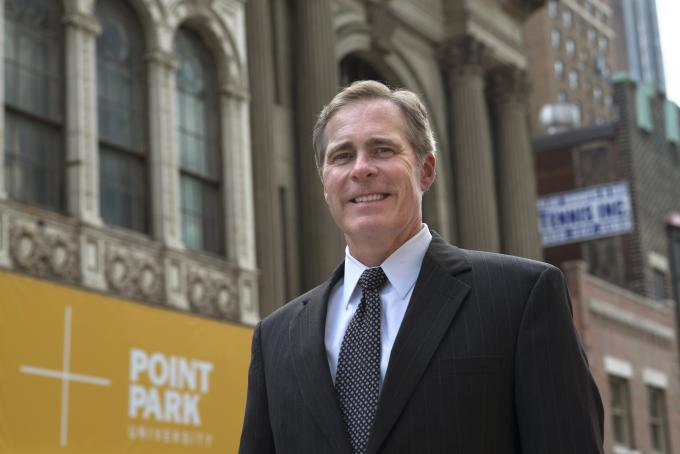New Playhouse will be artistic lab in Downtown Pittsburgh

The Point
Spring 2013
When the legendary Pittsburgh Playhouse became part of Point Park University in the late 1960s, the Oakland facility was rich in theater history but already outdated. The artistic training programs provided the foundation for what eventually became the Conservatory of Performing Arts (COPA), but the inadequate facilities at the Playhouse have not kept pace with the needs of students and patrons alike.
More than four decades later, the vision for a new Pittsburgh Playhouse, situated in the heart of Point Park's growing Downtown campus and linked to the city's nearby Cultural District, is about to unfold on Forbes Avenue at Wood Street.
According to President Paul Hennigan, plans for the new Playhouse began to take shape seven years ago, when Point Park started to expand its Downtown campus. "We have engaged the entire community, inside and outside the University, in our planning process," he says. "As a result, we received a strong endorsement from community members for our vision for a dynamic, urban University campus, and for relocating the Pittsburgh Playhouse in Downtown Pittsburgh."
Related Links
Not only is the new Playhouse critical to the mission of educating Conservatory students, the project also coincides with a burst of development in the immediate area, including the PNC tower now under construction and the revitalized Market Square, says Hennigan. "We realized that the timing couldn't be better to move the Playhouse to the forefront of our campus development plans."
An Academic and Artistic Crossroads
The new Playhouse is designed to be a six-story teaching and performance venue that will provide world-class professional spaces for everything from classical to unconventional productions. It will continue to serve as an academic laboratory for students, as well as a community theater that pioneers high-quality productions at a reasonable cost. The facility will also expand co-curricular opportunities for other University programs, such as the Sport, Arts and Entertainment Management program, the broadcast journalism and digital media programs, and much more.
The architectural plans for the new Playhouse incorporate Point Park's University Center (an ornate former bank building) at Forbes Avenue and Wood Street, some older structures that include the historic Stock Exchange Building on Fourth Avenue and several vacant lots.
A View into the Creative Process
A theme that runs throughout the design is the ability to engage the larger community with the ongoing activity inside the Playhouse, according to Hennigan, who says that the University found an ideal design partner in the Cleveland-based architectural firm Westlake Reed Leskosky.
Created in collaboration with the artists who will teach and learn in the building, the design reveals a portal to the arts and offers broad visual access both inside and out.
For example, large windows on the Forbes Ave. side will expose the artistic laboratory to the urban neighborhood, offering a view into the proscenium theater while set building, lighting checks, and rehearsals take place. Inside, creative activities such as costume design, filmmaking, and other production areas will be linked by access to the University Center and library, providing opportunities for interaction with Point Park's internal community as well as external visitors. Other design highlights include flexible seating and gathering areas, a soundstage, black box theater, café and outdoor plaza.
Backstage is Forestage
Designing an academic theater setting is very different than designing a commercial theater, says Hennigan. "In a commercial theater, patrons see only what's on stage, which represents less than half of the overall show. They don't see the other 50 to 75 percent - everything that goes into the making of a production. The new Playhouse will showcase 100 percent of the creative process - right up until the theater is darkened and the show begins." The concept is unique in Pittsburgh and may in fact be the only theater of its kind in the United States.
The openness to creative activities allows the facility to become an interior "urban street" where the arts are exposed and the backstage is forestage - where visual access promotes artistic collaboration. It will be an academic laboratory that spills into the street, offering a creative exchange between the University and its urban neighborhood.
"We think it's a game-changer," says Hennigan, "for Point Park and for Pittsburgh."
Text by Cheryl Valyo
Photo by Martha Rial
The Point is a magazine for alumni and friends of Point Park University.

